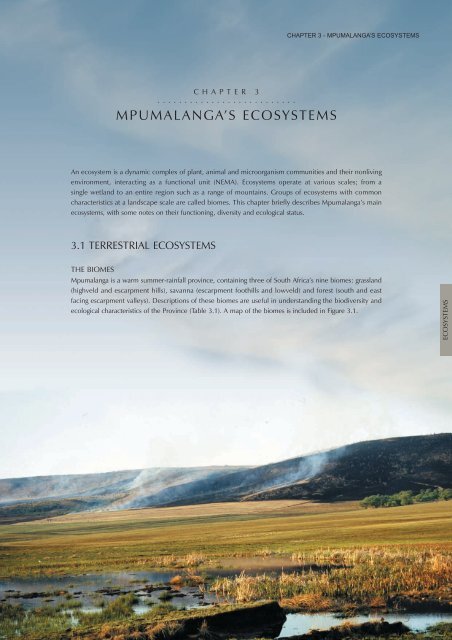Mpumalanga Biodiversity Conservation Plan Handbook - bgis-sanbi
Mpumalanga Biodiversity Conservation Plan Handbook - bgis-sanbi
Mpumalanga Biodiversity Conservation Plan Handbook - bgis-sanbi
Create successful ePaper yourself
Turn your PDF publications into a flip-book with our unique Google optimized e-Paper software.
CHAPTER 3<br />
..........................<br />
MPUMALANGA’S ECOSYSTEMS<br />
An ecosystem is a dynamic complex of plant, animal and microorganism communities and their nonliving<br />
environment, interacting as a functional unit (NEMA). Ecosystems operate at various scales; from a<br />
single wetland to an entire region such as a range of mountains. Groups of ecosystems with common<br />
characteristics at a landscape scale are called biomes. This chapter briefly describes <strong>Mpumalanga</strong>’s main<br />
ecosystems, with some notes on their functioning, diversity and ecological status.<br />
3.1 TERRESTRIAL ECOSYSTEMS<br />
CHAPTER 3 - MPUMALANGA’S ECOSYSTEMS<br />
THE BIOMES<br />
<strong>Mpumalanga</strong> is a warm summer-rainfall province, containing three of South Africa’s nine biomes: grassland<br />
(highveld and escarpment hills), savanna (escarpment foothills and lowveld) and forest (south and east<br />
facing escarpment valleys). Descriptions of these biomes are useful in understanding the biodiversity and<br />
ecological characteristics of the Province (Table 3.1). A map of the biomes is included in Figure 3.1.<br />
9<br />
ECOSYSTEMS

















